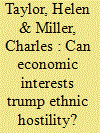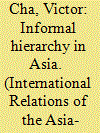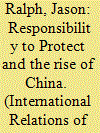|
|
|
Sort Order |
|
|
|
Items / Page
|
|
|
|
|
|
|
| Srl | Item |
| 1 |
ID:
155470


|
|
|
|
|
| Summary/Abstract |
What explains Japan’s security behavior? As an economically powerful state without commensurate military capabilities, Japan has long puzzled theorists of international relations. To explain this puzzle, many scholars have put forth arguments focusing on Japanese domestic institutions and anti-militarist ideas. In contrast, I argue that Japan’s security ‘production’ is primarily driven by two key variables: the regional threat environment and the strength of security commitment from its ally and great power patron, the United States. These two factors vary and interact in ways that determine Japan’s level of security, which drives its security policy. These arguments are illustrated through a longitudinal analysis of Japan’s security behavior, comprised four temporal ‘cases’ running from 1960 to the present day.
|
|
|
|
|
|
|
|
|
|
|
|
|
|
|
|
| 2 |
ID:
155469


|
|
|
|
|
| Summary/Abstract |
Will China’s rise be peaceful? One of the key reasons for an optimistic outlook is the extensive economic ties which exist between China and its neighbors. According to a venerable strand of thought among policymakers and scholars alike, trading ties ought to foster bonds of amity among nations and thus reduce the chances of war. Here, we test this proposition using spatial economic data and survey research on opinion toward China as a security threat in Australia. The structure of Australia’s economy, its reliance on exports to China, and the concentration of these exports in a small number of sectors make it an ideal venue for such a test. Consistent with previous literature on public opinion and globalization, but in contrast to an individual interests based account of the trade–peace relationship, we find that outgroup hostility, not economic interdependence, is the key factor in shaping voters’ fears of a Chinese security threat.
|
|
|
|
|
|
|
|
|
|
|
|
|
|
|
|
| 3 |
ID:
155466


|
|
|
|
|
| Summary/Abstract |
The U.S.-based alliance system in Asia has grown stronger since the end of the Cold War, not weaker. Indeed, Japan and the Republic of Korea each celebrated in recent years the 60th anniversary of their alliances with the United States with proclamations of continued resiliency and longevity. Why is this? How do great powers maximize their influence in regional security? Some might argue that the threat of a rising China provides the glue to the alliances’ longevity. But no country in the region is really looking to balance China as the raison d’ȇtre of their security relationship with America. I argue the San Francisco system’s durability today is found in the unique origins of the hub and spokes alliance system. The United States operationalized a strategy of ‘tight bilateralism’ that maximized power through the creation of formal networks and informal hierarchy in Asia. It established a formal network of alliances to deter the communist threat, but also to exercise control over these newfound allies. The United States had bilateral relationships in Europe, where it transacted business through deep bilateral ties, as well as through a regional organization; moreover, some multilateral coordination among the member states was encouraged. This was less the case in Asia. Instead, a ‘hub and spokes’ arrangement emerged in which all parties in the network were plugged into a central hub, but with almost no interaction among them. This formal hub and spokes network operated as an informal hierarchical arrangement with Taiwan, South Korea, Japan, and others that maximized U.S. power. Moreover, the arrangement was legitimized domestically in all of the member states. This structure and process contributed greatly to the bilateral alliance arrangement’s continuing durability, even today. In this article, I focus on Japan as the primary example of this hierarchy strategy of ‘tight bilateralism’ at work.
|
|
|
|
|
|
|
|
|
|
|
|
|
|
|
|
| 4 |
ID:
155471


|
|
|
|
|
| Summary/Abstract |
What is the effect of the spread of nuclear weapons on interstate conflict? Do nuclearizing states invite preventive attacks? If so, which states are likely to take such military actions? After dividing states into three groups – nuclear, nuclearizing, and non-nuclear – this study argues that once a state starts to develop nuclear weapons, it becomes a likely target of preventive attacks due to its uncertain capability and intention. Nuclear states are particularly expected to be aggressive against nuclearizing states due to the former’s perceived loss from nuclear proliferation. With empirical support from a statistical analysis from 1950 to 2000, this study implies that nuclear spread decreases international security because both its process (entailing the existence of a nuclear development program) and its desired outcome (achieving development of nuclear armaments) create targets and initiators of preventive conflicts.
|
|
|
|
|
|
|
|
|
|
|
|
|
|
|
|
| 5 |
ID:
155467


|
|
|
|
|
| Summary/Abstract |
The purpose of this article is to explore the development of a norm that emerged during a period of unqualified American hegemony – the Responsibility to Protect (R2P) – and to ask what the rise of China means for R2P norm entrepreneurs like Australia. It argues that by underpinning great power identity claims, which are instantiated by the assertion of normative positions occasionally at odds with liberal states, the rise of China has helped to highlight the contested nature of the R2P norm, in particular the license it notionally gives to the pursuit of externally imposed regime change. Drawing on an innovative combination of critical constructivism and philosophical pragmatism the paper argues that liberal states can better promote R2P in this increasingly pluralist international order by adopting a pragmatic approach to norm diffusion. This balances the demands of a dialog that is sensitive to Chinese concerns with the defense of the substantive core of the norm, human protection. It is further argued that Australia’s geopolitical position to Chinese power and an embedded identity narrative of Australia as a ‘middle power’ demonstrates a potential to act as a pragmatic norm entrepreneur. Indeed, Australia’s recent activity on the UN Security Council can be characterized in these terms.
|
|
|
|
|
|
|
|
|
|
|
|
|
|
|
|
|
|
|
|
|